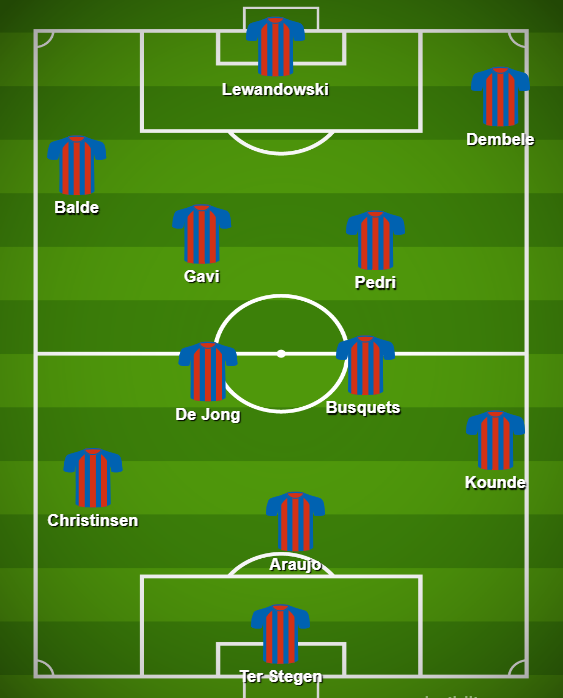The First Part of this series was all about Xavi's beginning. Now it's time to talk about Xavi's tactics.

This biggest issue in Xavi's career isn't necessarily his lack of experience as that could easily be compensated with the right. The problem is that compensation wasn't available. Whenever you look at Arsenal, Liverpool, Manchester City, and even Real Madrid, you need to know that the credit for their tactical superiority in a given match isn't always the result of the manager's ideas but rather one of the coaching staff, or a collective conclusion.
So, what was the issue with Barcelona?
Well, to get to the issue we must actually explore the tactics.
Barcelona starts each game in a simple 4-3-3 set-up. Some names are changeable but there are some constants, those constants are Lewandowski as a striker, Busquets as a defensive midfielder, a combination of 2 of either De Jong, Gavi, or Pedri in midfield, Dembele as a right winger, and either Raphinha or Ferran as a left winger.

The wingers are usually playing wide to take a player of the opponent's defence with them. The entire idea is that each attack ends with Lewandowski. To support Lewandowski, Gavi would often join him in the box, Pedri less so, and the team would look like this in the offensive phase.

There are a few problems with this, problems I think Xavi would have been made aware of had he not decided to nepotism-hire his brother and some coach whose last coaching experience was coaching in La Liga's second tier. The first problem is Busquets.
You might recall memes and criticism of Busquets during that era and that would have been justifiable if it weren't for the fact that the Spain national team didn't have the Busquets problem, mainly because, unlike in Barcelona, Busquets didn't have to cover such a vast space alone. Tactically, Busquets is a genius, but physically he is weak.
Busquets is a legend, the reason we appreciate the likes of Rodri, Kimmich, Rice, and other players in this often-forgotten position. He changed the role and requirements in that position. In fact, his absence can be felt in Barcelona this season. However, giving Busquets all that space is problematic for Barcelona. So, that's problem number 1.
The second problem is the wingers, they're both very wide. A simple look at teams like Arsenal, City, Liverpool, Real Madrid, Tottenham, you name the club, would show you that these clubs don't treat their wingers that way, at least one of them cuts inside, often both taking turns. But, Barcelona's idea is to give the ball to Dembele and hopefully, he takes on the defender successfully and creates an attack that Lewandowski finishes.
That is a gamble and has a low percentage of working because you start with Dembele having a 50% chance of succeeding in his take-on, then, less percentage with him having to make the right decision afterwards and even less with the fact that the finishing afterwards has to end in a goal. Bear in mind, we're talking about the only offensive idea Barcelona had.
A third problem is the fact that Barcelona's full-backs are rarely active. They don't contribute. They rarely push, they just stand there. So, the team is static, not a lot of manoeuvring, it all depends on some players being on their day. These three problems actually make each other worse and have to be fixed at the same time. So, how to fix them?
A Different Path to the Same Problems
The way to fix that actually has been all the rage recently in top teams in the idea of a midfield box. There are different ways to achieve it, Man City pushes Stones forward, Arsenal inverts Zinchenko, and Liverpool inverts Arnold, just as quick examples.
Xavi's approach did solve the Busquets problems but kept some other problems. You see while most teams transition into the box midfield, Xavi just starts with it. He plays Busquets, De Jong, Pedri, and Gavi together.

This created a great opportunity for Barcelona as it had the club's best technical players together in the midfield, there's a lot of room for manoeuvring. Busquets was protected, and Gavi provided some support to Lewandowski as evidenced by his goal in the Super Cup last season against Real Madrid.
Still, the team lacked dynamic movement, it was once again static. Dembele on one side, Balde on the other, and they either take on the defender successfully or Barcelona don't have a chance. We saw it countless times, Balde the ball and stopped for a few seconds shrugging and wondering what to do, nowhere to go, and no one to play with as triangles were no longer forming. Nothing to do by taking on the defender.
Notice that I used the term take on instead of the popular term dribble and that's intentional. A dribble can happen in any direction, a take-on has to happen toward the opponent's goal.
In a way, Barcelona won the league by opponents having equally bad seasons and by outperforming their expected stats. However, tactically, their problems continued until they played Atletico Madrid this season, but more on that in the next part.